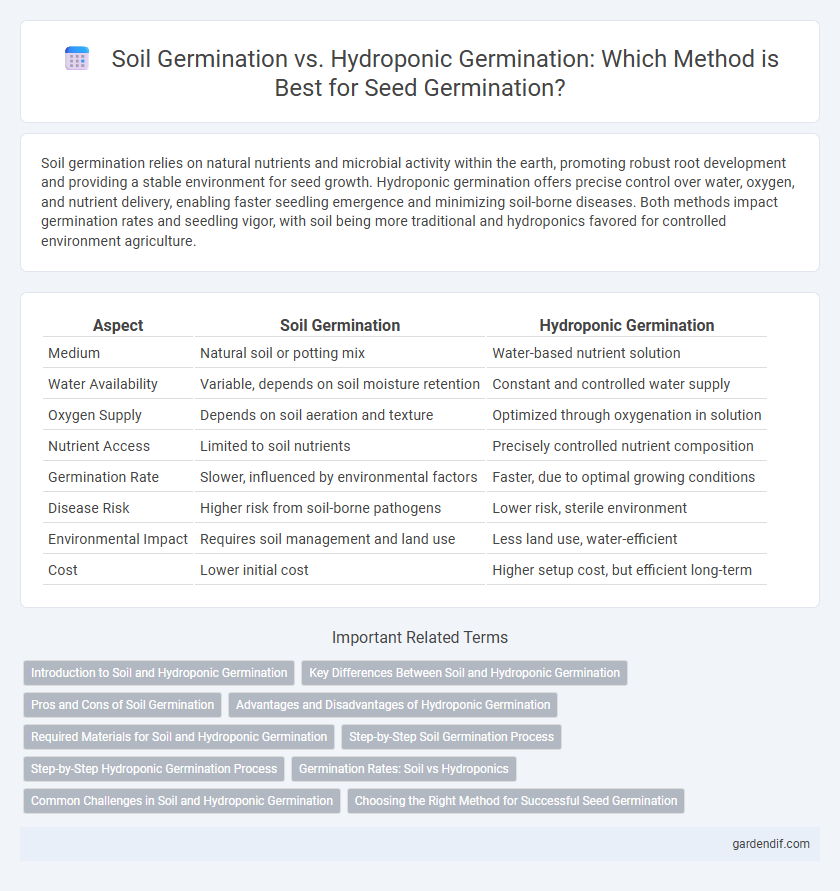
Soil Germination vs Hydroponic Germination Illustration
Soil germination relies on natural nutrients and microbial activity within the earth, promoting robust root development and providing a stable environment for seed growth. Hydroponic germination offers precise control over water, oxygen, and nutrient delivery, enabling faster seedling emergence and minimizing soil-borne diseases. Both methods impact germination rates and seedling vigor, with soil being more traditional and hydroponics favored for controlled environment agriculture.
Table of Comparison
| Aspect | Soil Germination | Hydroponic Germination |
|---|---|---|
| Medium | Natural soil or potting mix | Water-based nutrient solution |
| Water Availability | Variable, depends on soil moisture retention | Constant and controlled water supply |
| Oxygen Supply | Depends on soil aeration and texture | Optimized through oxygenation in solution |
| Nutrient Access | Limited to soil nutrients | Precisely controlled nutrient composition |
| Germination Rate | Slower, influenced by environmental factors | Faster, due to optimal growing conditions |
| Disease Risk | Higher risk from soil-borne pathogens | Lower risk, sterile environment |
| Environmental Impact | Requires soil management and land use | Less land use, water-efficient |
| Cost | Lower initial cost | Higher setup cost, but efficient long-term |
Introduction to Soil and Hydroponic Germination
Soil germination relies on nutrient-rich organic matter and natural microorganisms to support seed sprouting, providing stability and moisture retention for root development. Hydroponic germination uses a water-based, nutrient solution that allows precise control over oxygen, pH levels, and nutrient availability, fostering faster and more uniform seed growth. Both methods offer unique advantages, with soil emphasizing ecological balance and hydroponics maximizing resource efficiency and growth speed.
Key Differences Between Soil and Hydroponic Germination
Soil germination relies on natural nutrients, microbial activity, and aeration within organic matter, fostering root development through a well-balanced medium. Hydroponic germination uses nutrient-rich water solutions, providing precise control over nutrient delivery, pH levels, and oxygenation, resulting in faster and more uniform seed sprouting. Key differences include nutrient availability, environmental control, and growth speed, with hydroponics offering a more controlled environment for optimizing germination rates compared to traditional soil methods.
Pros and Cons of Soil Germination
Soil germination provides a natural environment rich in nutrients and beneficial microorganisms that support seedling growth, enhancing root development and disease resistance. However, soil germination poses challenges such as inconsistent moisture levels, risk of soil-borne diseases, and slower growth rates compared to hydroponic methods. Additionally, variability in soil quality can impact germination success and requires careful management to prevent fungal infections and nutrient imbalances.
Advantages and Disadvantages of Hydroponic Germination
Hydroponic germination allows for precise control over water, nutrients, and oxygen, resulting in faster seed sprouting and higher germination rates compared to soil germination. The absence of soil eliminates risks of soil-borne diseases and pests, reducing the need for pesticides and promoting cleaner plant development. However, hydroponic systems require initial investment in equipment, continuous monitoring, and technical expertise, which can be challenging for beginners and increase operational costs.
Required Materials for Soil and Hydroponic Germination
Soil germination requires nutrient-rich soil, pots or seed trays, and adequate watering tools to maintain moisture levels essential for seed sprouting. Hydroponic germination relies on inert growing mediums like coconut coir or rockwool, along with nutrient solutions and specialized hydroponic systems such as trays or reservoirs to deliver water and nutrients directly to the seeds. Both methods demand controlled environments, but hydroponics eliminates soil, reducing the risk of soil-borne diseases and allowing precise nutrient management.
Step-by-Step Soil Germination Process
Soil germination involves preparing nutrient-rich, well-draining soil as the foundational medium, ensuring optimal moisture and temperature conditions between 65-75degF for seed sprouting. Seeds are planted at an appropriate depth, typically twice their size, covered lightly with soil, and regularly watered to maintain consistent humidity without waterlogging. Monitoring germination progress over 7-14 days allows for adjusting environmental factors to maximize seedling vigor and successful soil-based plant growth.
Step-by-Step Hydroponic Germination Process
Hydroponic germination involves soaking seeds in a nutrient-rich solution, followed by placing them on a moist, inert growing medium such as rockwool or coconut coir to maintain optimal moisture and oxygen levels. Maintaining a temperature range of 20-25degC and providing indirect light ensures consistent seed sprouting within 3 to 7 days. Regular monitoring of pH levels between 5.5 and 6.5, along with gentle aeration of the nutrient solution, promotes healthy root development during the initial germination phase.
Germination Rates: Soil vs Hydroponics
Hydroponic germination typically achieves higher germination rates compared to soil due to controlled environmental factors such as consistent moisture, oxygen availability, and nutrient supply. Soil germination rates can vary widely depending on soil composition, temperature, and moisture levels, often resulting in slower or uneven seed sprouting. Studies show hydroponic systems can increase germination success by up to 20%, offering more predictable and efficient plant propagation.
Common Challenges in Soil and Hydroponic Germination
Soil germination frequently faces challenges such as uneven moisture distribution, soil-borne diseases, and inconsistent nutrient availability that can hinder seedling development. Hydroponic germination often struggles with maintaining optimal water pH, nutrient imbalances, and the risk of root rot due to excess moisture. Both methods require precise environmental control to prevent common issues like fungal infections and poor oxygenation affecting seed germination rates.
Choosing the Right Method for Successful Seed Germination
Soil germination provides natural nutrients and beneficial microbes essential for early seedling growth, creating a robust root system, while hydroponic germination offers precise control over water, oxygen, and nutrient delivery, leading to faster germination rates and reduced risk of soil-borne diseases. Selecting the appropriate method depends on factors like seed type, growth environment, and resource availability; seeds requiring consistent moisture and aeration often thrive in hydroponic systems, whereas those favoring organic soil conditions benefit from traditional soil germination. Understanding the specific needs of the plant species and growth goals is crucial for optimizing germination success and ensuring healthy seedling development.
Soil Germination vs Hydroponic Germination Infographic

 gardendif.com
gardendif.com